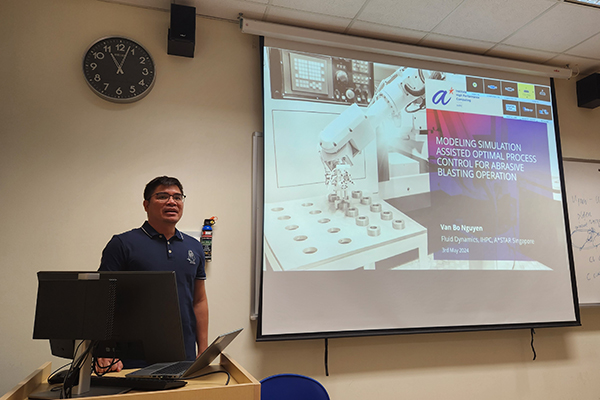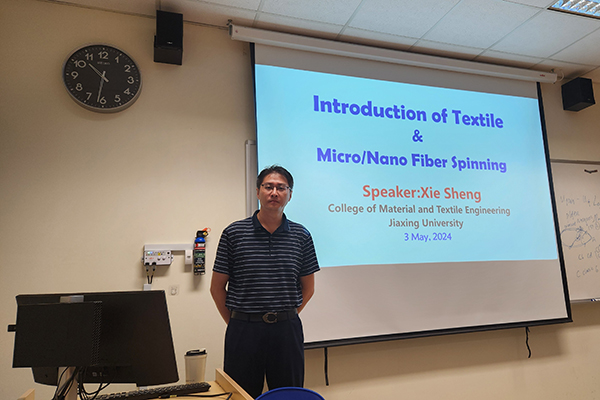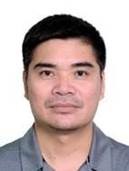Seminar
Textile Engineering & Micro / Nano Fiber Spinning |
| 3 May 2024, Friday, 10:30 - 11:00am | Speaker: Dr. Xie Sheng, Associate Professor, College of Material and Textile Engineering, Jiaxing University |
| Venue: Seminar Room 8D-1, Level 8, Temasek Laboratories | Event Organiser Host: Dr. Huang Xin |
|
ABSTRACT |
Due to my special major background in T-Lab, in the presentation, I will firstly introduce the textile engineering according to the order of textile manufacure processing (from textile fiber to yarn, fabrics, dyeing and finishing). Then, two crucial approaches for preparing micro/nano fibers, melt blowing and electrospining, will be shown. Melt blowing and electrospinning products has important using in filtration, insulating, absorbtion, and bioengineering, etc. |
| ABOUT THE SPEAKER |
|

Optimal Model-Based Control for Automated Robotized Abrasive Blasting System |
| 3 May 2024, Friday, 11:00 - 11:30am | Speaker: Dr. Nguyen Van Bo, Research Scientist, Institute of High Performance Computing |
| Venue: Seminar Room 8D-1, Level 8, Temasek Laboratories | Event Organiser Host: Dr. Huang Xin |

ABSTRACT |
In robotic abrasive blasting operations, achieving the required surface roughness and cleanliness relies heavily on manually pre-set operational parameters. These parameters, such as stand-off distance, blasting angle, inlet air pressure, abrasive flow rate, and particle size, are set based on operator experience. However, given that optimal values for these parameters vary depending on specific blasting conditions and surface requirements, the pre-set values often fail to deliver both the desired surface quality and productivity. To address these challenges, we propose a solution employing a set of proxy models and a model predictive control system to achieve optimal operational outputs. For energy efficiency and productivity maximization, we utilize computational fluid dynamics with a multiphase flow solver to determine the optimal stand-off and offset distances, thus controlling the blasting nozzle effectively. Additionally, we build a data-driven model to obtain the optimal reference set point of air pressure at the sensor location based on the desired surface roughness. Moreover, we develop a dynamic process model to link the inlet air pressure and abrasive flow rate to the air pressure at the sensor location, which facilitates the development of a model-based control system. By applying this comprehensive approach, we evaluate and optimize the control and operational parameters to achieve the desired surface roughness and productivity targets. To validate the effectiveness of our newly developed control system and models, extensive tests are conducted both virtually (in silico) and on-site. The results confirm the stability and accuracy of the control system. In on-site reliability tests, the automated blasting system successfully delivers the desired surface roughness with a relative error of less than 5% and a remarkable 30-50% improvement in productivity. Overall, our innovative control system and models offer a reliable and efficient solution for robotic abrasive blasting, ensuring consistent surface quality and productivity enhancements. |
| ABOUT THE SPEAKER |
|




 Dr. Xie Sheng is a associate professor in college of material and textile engineering at Jiaxing University. His research centers on understanding the spinning mechanism of melt blowing(MB) and new material's melt spinning in MB,like water-solved PVA material. Xie earned his Ph.D degree in textile engineering for Donghua Universtiy in 2015, his dissertation was about melt blowing air flow and fiber motion. He worked as post doctoral at Zhejiang University(2018-2021) and Soochow University(2022-2023). Dr. Xie has published 21 SCI papers and have 10 chinese national invention patents. He has been financial supported by National natural science foundation of China(2018-2020), Chinese post docteral fundation(2018-2019) and Jiaxing city natural science fundation(2022-2024).
Dr. Xie Sheng is a associate professor in college of material and textile engineering at Jiaxing University. His research centers on understanding the spinning mechanism of melt blowing(MB) and new material's melt spinning in MB,like water-solved PVA material. Xie earned his Ph.D degree in textile engineering for Donghua Universtiy in 2015, his dissertation was about melt blowing air flow and fiber motion. He worked as post doctoral at Zhejiang University(2018-2021) and Soochow University(2022-2023). Dr. Xie has published 21 SCI papers and have 10 chinese national invention patents. He has been financial supported by National natural science foundation of China(2018-2020), Chinese post docteral fundation(2018-2019) and Jiaxing city natural science fundation(2022-2024). Dr. Van Bo Nguyen obtained his PhD in computational engineering at the Singapore-Massachusetts Institute of Technology Alliance (SMA) Programme in May 2011. He was a postdoc at National University of Singapore (NUS) and then research scientist at the Institute of High Performance Computing (IHPC), Agency for Science, Technology and Research (A*STAR), then senior research scientist at Temasek Laboratories, NUS. Since February 2018 he has been a Scientist III at IHPC, A*STAR. He is currently a Research Scientist in Computational Engineering for Advanced Manufacturing Processes and Control, at the Institute of High Performance Computing (A*STAR IHPC). His interests is in chemical reacting flow applications (reduced order model; physical data driven).
Dr. Van Bo Nguyen obtained his PhD in computational engineering at the Singapore-Massachusetts Institute of Technology Alliance (SMA) Programme in May 2011. He was a postdoc at National University of Singapore (NUS) and then research scientist at the Institute of High Performance Computing (IHPC), Agency for Science, Technology and Research (A*STAR), then senior research scientist at Temasek Laboratories, NUS. Since February 2018 he has been a Scientist III at IHPC, A*STAR. He is currently a Research Scientist in Computational Engineering for Advanced Manufacturing Processes and Control, at the Institute of High Performance Computing (A*STAR IHPC). His interests is in chemical reacting flow applications (reduced order model; physical data driven).